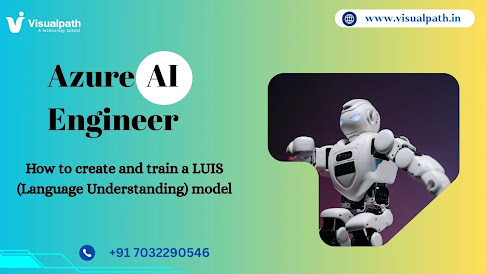How to create and train a LUIS (Language Understanding) model
How to create and train a LUIS (Language Understanding) model
Building intelligent conversational applications requires natural
language understanding (NLU). Microsoft Azure provides Language Understanding
(LUIS), a cloud-based API service that allows developers to build applications
capable of interpreting human language. In this article, we’ll explore how to create
and train a LUIS model, and the key steps involved in designing, training,
and deploying it for real-world AI solutions.
Suppose you are learning through Microsoft Azure AI Online Training. In that case, you will quickly realize that LUIS plays a critical
role in conversational AI, enabling apps, chatbots, and services to extract
meaning from user input. Let’s break down the process step by step.
%20model.webp) |
| How to create and train a LUIS (Language Understanding) model |
1. Understanding the Basics of LUIS
Before creating a model, it’s important to understand the key building
blocks of LUIS:
·
Intents – Define the
purpose of the user’s input (e.g., “BookFlight”).
·
Utterances – Examples of
phrases a user might say (e.g., “I want to book a ticket to Delhi”).
·
Entities – Extract specific
details from utterances (e.g., location, date, time).
These components work together to ensure your application understands
user queries in a structured way.
2. Setting Up a LUIS Resource in Azure
To begin:
1.
Log in to the Azure Portal.
2.
Create a new Language
Understanding (LUIS) resource.
3.
Assign a name, subscription, and region for your resource.
4.
Once deployed, you can access the LUIS portal for building models.
This step ensures your model is hosted in the cloud, ready for
development and deployment.
3. Creating a LUIS App
After setting up the resource:
1.
Navigate to the LUIS portal.
2.
Click New App and provide an application name.
3.
Add intents representing user goals. For example, an intent
“WeatherInfo” might capture queries like “What’s the weather in Hyderabad?”
4.
Define utterances under each intent to train the system.
This structured setup forms the foundation of your model.
4. Adding Entities to Extract Data
Entities play a vital role in capturing important details. For example:
·
Prebuilt Entities: Such as numbers,
dates, and locations.
·
Custom Entities: You define them
based on domain-specific needs (e.g., “destination city”).
By combining intents and entities, your LUIS app can handle real-world
user queries more effectively.
5. Training the LUIS Model
At this stage, you’ll train your LUIS model using sample data:
1.
Provide multiple utterances under each intent.
2.
Label entities within those utterances.
3.
Click Train in the LUIS portal to allow the system to learn
patterns.
The more diverse your training data, the more accurate the model becomes
in understanding new inputs.
6. Publishing the Model
Once training is complete:
1.
Publish the model to a production slot.
2.
Retrieve the endpoint URL and key from the LUIS portal.
3.
Integrate this endpoint into your chatbot or application.
At this point, your app can call the LUIS API to interpret user queries
in real time.
7. Integrating LUIS with Applications
With your model deployed, you can connect it to:
·
Azure Bot Service for building
chatbots.
·
Custom applications using
REST API or SDKs.
·
Third-party platforms such
as Microsoft Teams or websites.
In professional setups, as emphasized in Microsoft Azure
AI Engineer Training, integrating LUIS with conversational bots and
automation workflows is a vital skill for building enterprise-grade AI
solutions.
8. Best Practices for Training LUIS
Models
To improve performance and accuracy:
1.
Use at least 15–20 utterances per intent.
2.
Regularly retrain the model with new user data.
3.
Avoid overlapping intents that confuse classification.
4.
Test the model frequently with varied input examples.
5.
Monitor analytics to refine intents and entities.
These practices ensure your model adapts to real-world use and continues
to evolve.
9. Monitoring and Improving Your Model
Azure provides tools to analyze predictions and identify weaknesses in
your model. By reviewing endpoint logs and user interactions, you can retrain
your LUIS app to address gaps. Ongoing monitoring ensures your AI application
remains reliable and accurate.
By combining these techniques with structured learning such as Azure AI Engineer
Training, you can master LUIS and leverage it for chatbots, enterprise
apps, and cognitive services that understand human language effectively.
Conclusion
Creating and training a LUIS model
is a powerful way to enable natural language understanding in modern
applications. From setting up a resource and defining intents, to training,
publishing, and integrating the model, every step is crucial for building
intelligent solutions.
Trending Courses: SAP CPI, Snowflake, Azure
Data Engineering,
Visualpath stands out as the best
online software training institute in Hyderabad.
For More Information about the Azure AI
Engineer Online Training
Contact Call/WhatsApp: +91-7032290546
Visit: https://www.visualpath.in/azure-ai-online-training.html


.jpg)
Comments
Post a Comment